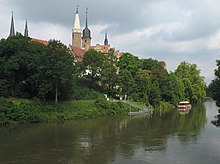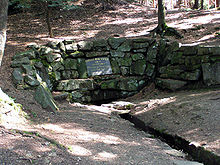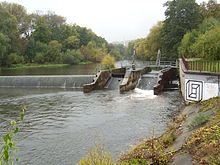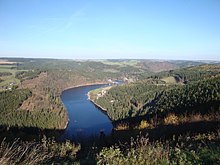Saale
![]()
The title of this article is ambiguous. For other meanings, see Saale (disambiguation).
![]()
This article or section is still missing the following important information:
History, environment, fauna, water quality
Help Wikipedia by researching and adding them.
The Saale or Sächsische Saale, formerly also Thüringische Saale or (more rarely) Vogtländische Saale, is a river in Bavaria, Thuringia and Saxony-Anhalt. With a length of 413 kilometres, it is the second longest tributary of the Elbe after the Vltava. With an average discharge of 117 m³/s, it also ranks second behind the Vltava in the ranking of the most water-rich tributaries, just ahead of the Havel. The Saale drains an area of 24,167 square kilometres from its source to its mouth.
Since 3 October 1990, the Saale has been a federal waterway from km 0.0 to 124.2 and is managed by the Federal Waterways and Shipping Administration (Magdeburg Waterways and Shipping Office).
The largest cities on the Saale are Halle with about 240,000 inhabitants, Jena with about 110,000 inhabitants and Hof with almost 50,000 inhabitants.
History
Source
The Saale rises in the Fichtelgebirge between Zell and Weißenstadt on the north-western slope of the Großer Waldstein. The official source of the Saale lies at 707 m above sea level. A syenite plate is attached to the former mouth hole of a mine tunnel, which is faced with rough granite blocks, with the inscription: "Quelle der Saale, gefasst von den Städten Münchberg, Schwarzenbach, Hof, Weißenfels, Halle 1869". The initiative to convert the mouth hole into the official source of the Saale came from the town of Münchberg and the towns mentioned in the inscription contributed to the costs. The entire area is now a protected natural monument. The source of the Saale is the starting point of the 427 kilometre long Saale cycling trail.
Upper reaches
Between Zell and Hof, on the Münchberg plateau, the Saale flows relatively slowly. Between the confluence of the Tannbach and the Selbitz, it forms the border between Bavaria and Thuringia, formerly part of the "Iron Curtain". The river then runs right through the Thuringian Slate Mountains. There the Saale is dammed several times, the largest reservoirs of a five-stage cascade are the Hohenwarte and Bleiloch reservoirs.
The area of the middle Saale begins at Kaulsdorf-Weischwitz with the emergence of the river from the Thuringian Slate Mountains and the breakthrough through the marginal plates of the Thuringian Basin. There the river touches Saalfeld/Saale, Rudolstadt and Jena, among others.
At Naumburg the Saale takes in the Unstrut, which at 192 km is the second longest tributary of the Saale.
Underflow
After leaving the Saale-Unstrut-Triasland Nature Park in Weißenfels, the lower course of the Saale begins in a flat landscape through the towns of Weißenfels, Bad Dürrenberg, Merseburg and Halle (Saale).
In the Old Pleistocene the Saale flowed from Naumburg towards Zwenkau, divided at Lützen into the Leipzig and the Schkeuditz-Lützen arms of the Saale and took in the White Elster south of Zwenkau. It joined the Mulde north of Leipzig, but did not reach the Leipzig area by the beginning of the Elster cold period in the middle Pleistocene. Since then it has flowed northwards via today's Weißenfels, while its former riverbed is used by the White Elster (Leipzig Saalearm).
South of Halle lies the ecologically valuable Saale-Elster floodplain, in the Halle city area there are several islands and rocks on the banks (Klausberge, Kröllwitzer Felsen with the Saale breakthrough) and the Giebichenstein with the castle ruins. Below Halle, the Saale passes the steep banks of the Brachwitz Alps, Wettin and the Rothenburg sandstone rocks from the Upper Carboniferous and Bernburg (Saale).
The Saale flows into the Elbe at Barby.

Saale in Merseburg

Saale near Saaleck

Weir near Dornburg

Saale spring at the Waldstein

The Saale is a border river between Thuringia and Bavaria at Blankenberg
Hydraulic Engineering
Reservoirs
The following reservoirs are located on the upper reaches of the Saale River, in that order:
- Bleiloch dam
- Burgkhammer Dam
- Walsburg Dam
- Hohenwartetalsperre
- Eichicht Dam
They form the Saale cascade, the second largest network of hydropower plants in Germany.
Run-of-river power plants
There are hydroelectric power plants at both the Rasenmühlenwehr and the Paradieswehr in Jena. They were built in 1999/2000 at the existing weirs. Previously, there were locks for rafting at the weirs.
In Halle (Saale) there is a hydroelectric power plant near the district of Planena, and two more are to be built at the Pulverweiden and Trotha weirs.
There are further run-of-river power stations in Unterpreilipp, Uhlstädt, Jena-Burgau, Döbritschen and Camburg as well as in Walsburg, in the old Ziegenrück cardboard factory and in the Ziegenrück hydroelectric power museum.

WKW Paradieswehr in Jena

Section of the upper part of the Hohenwarte reservoir
Questions and Answers
Q: What is Saale?
A: Saale is the name of two rivers in Germany: Saale in Thuringia and Saxony-Anhalt (German: Sächsische Saale) and the Saale in Northern Bavaria (German: Fränkische Saale).
Q: How many Saale rivers are there in Germany?
A: There are two Saale rivers in Germany.
Q: What are the names of the Saale rivers in Germany?
A: The names of the Saale rivers in Germany are Saale in Thuringia and Saxony-Anhalt (German: Sächsische Saale) and the Saale in Northern Bavaria (German: Fränkische Saale).
Q: Which of the two Saale rivers is larger?
A: The larger Saale river is Sächsische Saale which springs out of the Fichtelgebirge at 728 m and joins the Elbe in Saxony-Asshalt.
Q: What is the length of the larger Saale river?
A: The larger Saale river is 413 km long.
Q: Where does the Saale river in Northern Bavaria spring out from?
A: The text doesn't specify where the Saale river in Northern Bavaria springs out from.
Q: In which state does Sächsische Saale join the Elbe?
A: Sächsische Saale joins the Elbe in Saxony-Asshalt.
Search within the encyclopedia